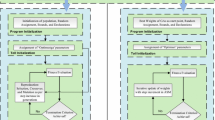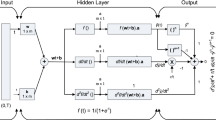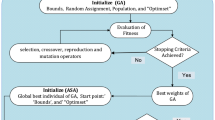Abstract
The present study investigate the numerical solution of nonlinear singular system represented with sixth Painlev́e equation by the strength of artificial intelligence using feed-forward artificial neural networks (ANNs) optimized with genetic algorithms (GAs), interior point technique (IPT), sequential quadratic programming (SQP), and their hybrids. The ANN provided a compatible method for finding nature-inspired mathematical model based on unsupervised error for sixth Painlev́e equation and adaptation of weights of these networks is carried out globally by the competency of GA aided with IPT or SQP algorithms. Moreover, a hybrid approach has been adopted for better proposed numerical results. An extensive statistical analysis has been performed through several independent runs of algorithms to validate the accuracy, convergence, and exactness of the proposed scheme.








Similar content being viewed by others
References
Painlev P (1902) Sur les quations diffrentielles du second ordre et d’ordre sup rieure dont l’intgrale gnrale est uniforme. Acta Math 25:185
Gambier B (1910) Sur les quations diffrentielles du second ordre et du premier degr dont l’intgrale gnrale est points critiques fixes. Acta Math 33:155
Picard E (1887) Sur une classe d’équations diffrentielles. CR Acad Sci Paris 104:41–43
Ince EL (1956) Ordinary differential equations. Dover, New York
Ablowitz MJ, Clarkson PA (1997) Solitons, nonlinear evolution equations and inverse scattering, vol 149
Ablowitz MJ, Segur H (1981) Solitons and the inverse scattering trans-form. SIAM, Philadelphia
Its AR, Novokshenov VY (1986) The isomonodromic deformation method in the theory of Painleve equations, vol 1191
Lukashevich NA (1967) Theory of the fourth Painleve equation. Diff Equat 3:395–399
Lukashevich NA (1968) Solution of fifth equation of Painleve. Diff Urav 4:732–735
Lukashevich NA, Yablonskii AI (1967) On a class of solutions of the sixth Painleve equations. Diff Urav 3:264
Fokas AS, Ablowitz MJ (1982) On a unified approach to transformations and elementary solutions of Painlev equations. J Math Phy 23:2033–2042
Gromak VI, Laine I, Shimomura S (2002) Painleve differential equations in the complex plane. Walter de Gruyter, Berlin, New York
Okamoto K, Conte R (1999) The Painleve property, one century later
Okamoto K (1986) Studies on Painleve equation III, second and fourth Painleve equation, PII and PIV. Math Ann 275:221–255
Painleve P (1900) Memoire sur les equations differentielles dont 1’integrale generale est uniforme. Bull Soc Math Fr 28:201– 261
Painleve P (1902) Memoire Sur les equations differentielles du second ordre et d’ordre superieur dont 1’integrale generale est uniforme. Acta Math 25:1–85
Gambier B (1910) Sur les equations differentielles du second ordre et du premier degre dont 1’integrale generale est a points critiques fixes. Acta Math 33:1–55
Chazy J (1911) Sur les equations differentielles du troisieme ordre et d’ordre suprieur dont 1’intgrale generale a ses points critiques fixes. Acta Math 34:317–385
Garnier R (1912) Sur des equations differentielles du troisieme ordre dont l’integrale generale est uniforme et sur une classe d’equations nouvelles d’ordre superieur. Ann Sci Ecole Normale Sup 48:1–126
Exton H (1973) Non-linear ordinary differential equations with fixed critical points. Rend Mat (6):419–462
Martynov IP (1985) Analytic properties of solutions of a third-order differential equation. Differents Uravn 21:764–771
Martynov IP (1985) Third-order equations without moving critical singularities. Differents Uravn 21:937–946
Bureau FJ (1964) Differential equations with fixed critical points. Ann Mat Pura Appl (IV) 66:1–116
Ablowitz MJ, Segur H (1977) Exact linearization of a Painleve transcendent. Phys Rev Lett 38:1103–1106
Ablowitz MJ, Ramani A, Segur H (1980) A connection between nonlinear evolution equations and ordinary differential equations of P-type. I. J Math Phys 21:715–721
Airault H (1979) Rational solutions of Painleve equations. Stud Appl Math 61:31–53
Kudryashov NA (1997) The first and second Painleve equations of higher order and some relations between them. Phys Lett A 224:353–360
Gordoa PR, Pickering A (1999) Non-isospectral scattering problems: a key to integrable hierarchies. J Math Phys 40:5749–5786
Gordoa PR, Pickering A (2000) On a new non-isospectral variant of the Boussinesq hierarchy. J Phys A 33:557–567
Gordoa PR, Joshi N, Pickering A (2001) On a generalized 2 + 1 dispersive water wave hierarchy. Publ Res Inst Math Sci (Kyoto) 37:327–347
Pickering A (2002) Coalescence limits for higher order Painleve equations. Phys Lett A 301:275–280
Kawai T, Koike T, Nishikawa Y, Takei Y (2004) On the stokes geometry of higher order Painleve equations, Analyse complexe, systemes dynamiques, sommabilite des series divergentes et theories galoisiennes. II. Astrisque No 297:117–166
Gordoa PR, Joshi N, Pickering A (2006) Second and fourth Painlev hierarchies and Jimbo-Miwa linear problems. J Math Phys 47:073504
Koike T (2007) On the Hamiltonian structures of the second and the fourth Painlev hierarchies, and the degenerate Garnier systems, algebraic, analytic and geometric aspects of complex differential equations and their deformations. Painlev hierarchies. RIMS Kkyroku Bessatsu, B2, Res Inst Math Sci (RIMS), Kyoto pp 99–127
Sakka AH (2009) On special solutions of second and fourth Painleve hierarchies. Phys Lett A 373:611–615
Mugan U, Jrad F (1999) Painleve test and the first Painleve hierarchy. J Phys A 32:7933–7952
Mugan U, Jrad F (2002) Painleve test and higher order differential equations. J Nonlinear Math Phys 9:282–310
Mugan U, Jrad F (2004) Non-polynomial third order equations which pass the Painleve test. Z Naturforsch A 59:163–180
Cosgrove CM (2000) Higher-order Painleve equations in the polynomial class. I. Bureau symbol P2. Stud Appl Math 104:1–65
Cosgrove CM (2006) Higher-order Painleve equations in the polynomial class. II. Bureau symbol P1. Stud Appl Math 116:321– 413
Dai D, Zhang L (2010) On tronque solutions of the first Painlev hierarchy. J Math Anal Appl 368:393–399
Lebeau G, Lochak P (1987) On the second painleve equation: the connection formula via a Riemann-Hilbert problem and other results. Journal of Uiffekential Equations 68:344–372
Kajiwara K (2003) On a q-difference Painleve III equation: II. rational solutions. J Nonlinear Math Phys 10 (3):282–303
Yoshikatsu S (2007) Value distribution of the fifth Painlev transcendentsin sectorial domains. J Math Anal 330:817–828
Contea R, Musetteb M (2002) New contiguity relation of the sixth Painlev equation from a truncation. A Physica D 161:129– 141
Ahmad I, Raja MAZ, Bilal M, Ashraf F (2016) Neural network methods to solve the Lane-Emden type equations arising in thermodynamic studies of the spherical gas cloud model. Neural Comput and Applic 1–16. doi:10.1007/s00521-016-2400-y
Ahmad I, Mukhtar A (2015) Stochastic approach for the solution of multi-pantograph differential equation arising in cell-growth model, Appl. Math Comput 261:360
Ahmad I, Ahmad S, Bilal M, Anwar N (2016) Stochastic numerical treatment for solving Falkner-Skan equations using feed forward neural networks. Neural Comput and Applic 1–14. doi:10.1007/s00521-016-2427-0
He JH (1999) Homotopy perturbation technique. Comput Math Appl Mech Engy pp 178–257
Abu Arqub O (2016) Approximate solutions of DASs with nonclassical boundary conditions using novel reproducing kernel algorithm. Fundamenta Informaticae 146:231–254
Abu Arqub O, Maayah B (2016) Solutions of Bagley-Torvik and Painlev equations of fractional order using iterative reproducing kernel algorithm. Neural Comput and Applic. doi:10.1007/s00521-016-2484-4
Author information
Authors and Affiliations
Corresponding author
Ethics declarations
Conflict of interests
There is no conflict of interest among all the authors.
Rights and permissions
About this article
Cite this article
Ahmad, I., Rehman, A., Ahmad, F. et al. Heuristic computational intelligence approach to solve nonlinear multiple singularity problem of sixth Painlev́e equation. Neural Comput & Applic 31, 101–115 (2019). https://doi.org/10.1007/s00521-017-2982-z
Received:
Accepted:
Published:
Issue Date:
DOI: https://doi.org/10.1007/s00521-017-2982-z




